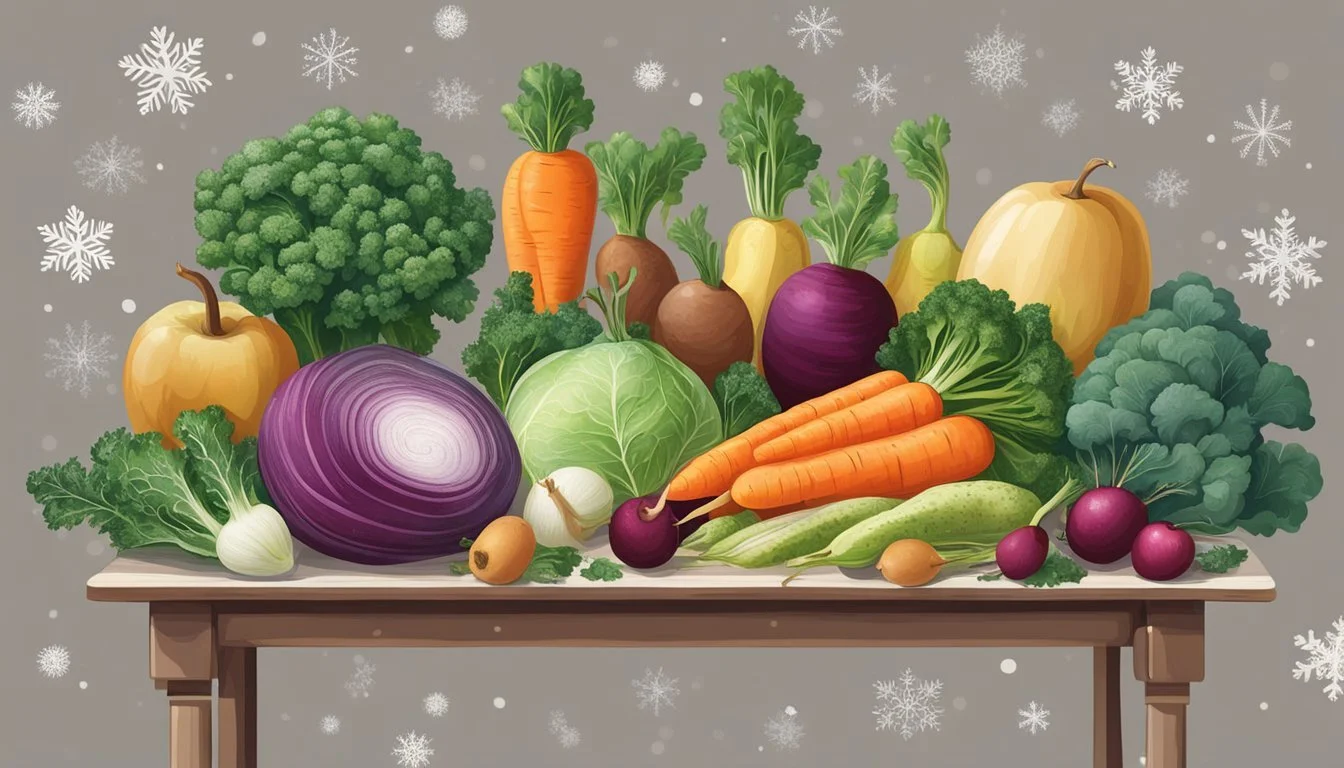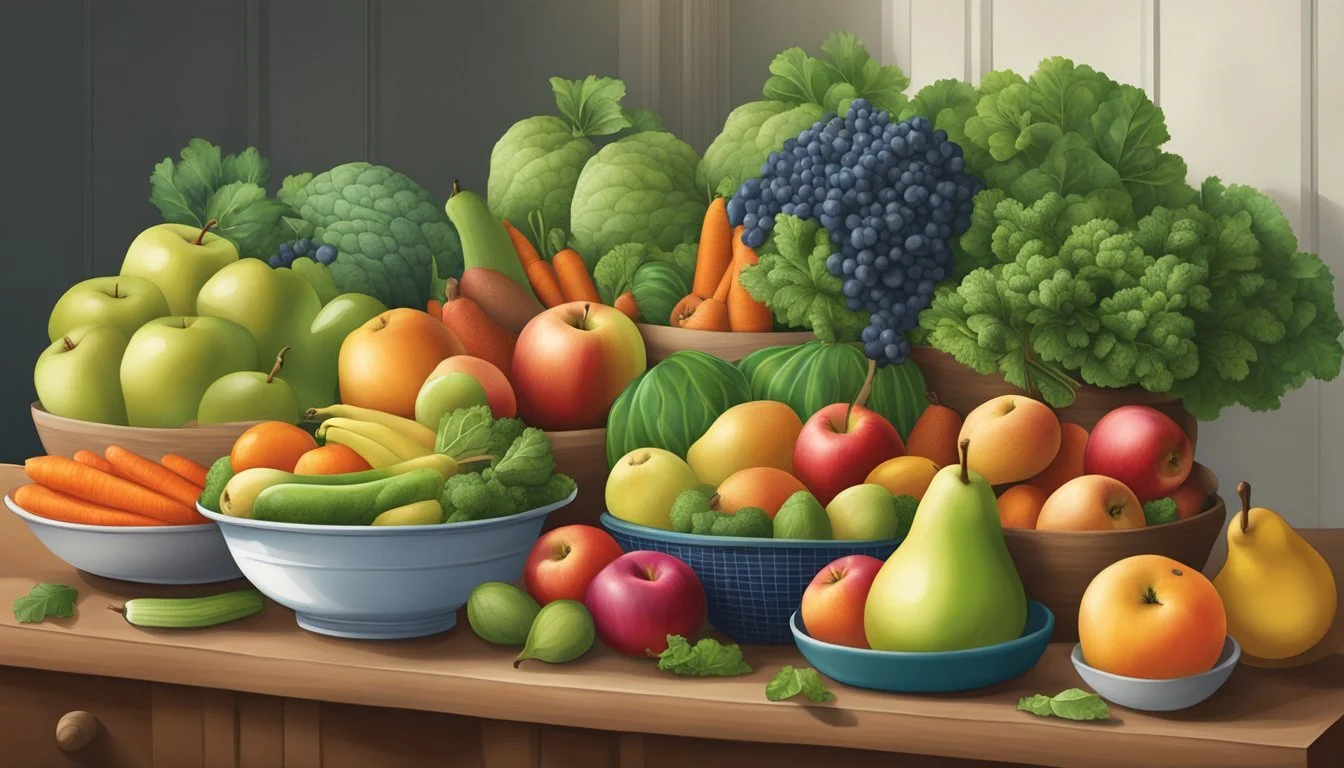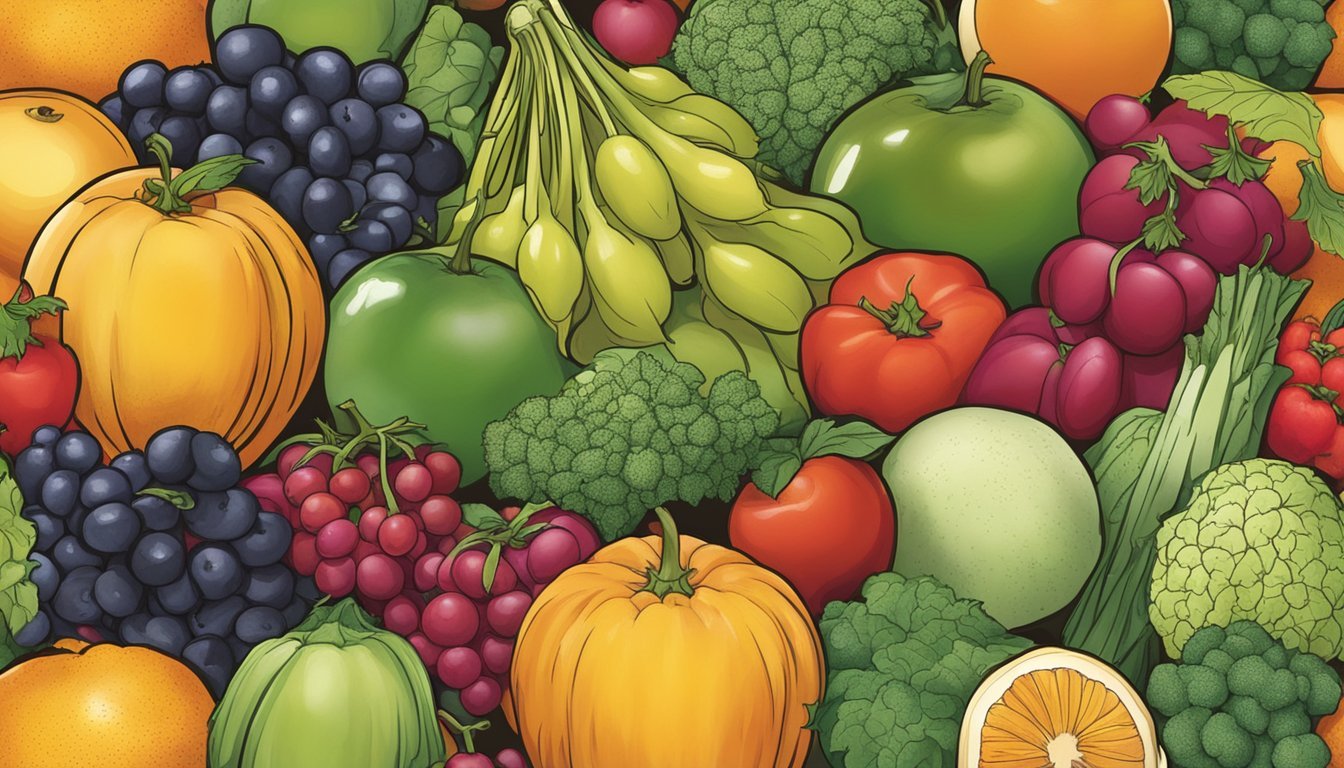Illinois Seasonal Fruit & Vegetables in January
Your Guide to Fresh Produce
This Article is Part of our Illinois Seasonal Fruit & Veg Calendar
In the heart of winter, Illinois offers a variety of seasonal produce that can brighten up meals with fresh flavors despite the chilly weather. January in Illinois is a time for hardy vegetables and storage crops that thrive in the cold or are available due to preservation techniques from previous harvests. While the selection may not be as vast as the summer months, consumers can still enjoy a range of nutritious options.
Root vegetables and cruciferous crops are particularly prominent during this time of the year. Items like carrots (how long do carrots last?) and beets (how long do beets last?), which are harvested before the frost and stored, continue to be available. Additionally, cruciferous vegetables such as kale and broccoli (how long does broccoli last?), which can endure the cooler temperatures, often make their way to farmers' markets and grocery stores.
Residents of Illinois are encouraged to take advantage of these seasonal offerings to support local agriculture and to incorporate a dash of variety into their winter diets. Consuming locally-sourced produce not only helps to sustain the regional economy, but also ensures a fresher and potentially more nutrient-rich addition to one's table.
Understanding Seasonality in Illinois
In January, Illinois' winter season significantly influences the availability of fresh fruits and vegetables at local markets. The state's climate during this month typically dictates a harvest of hardy, cold-tolerant crops.
Winter Harvest
During the cold winter months in Illinois, most of the local produce consists of storage crops and those that can withstand frost. Root vegetables and leafy greens that thrive in cooler temperatures are commonly found. At markets, January's selection is more limited, but one may find:
Vegetables: Potatoes, carrots, and onions from storage, along with fresh greens such as kale and spinach.
Fruits: While fresh local fruits are scarce, apples and pears may still be available from cold storage.
Regional Climate Impact
Illinois' winter climate, with its low temperatures and frost, necessitates a shift in what is actively growing. However, innovative farming techniques such as indoor greenhouse cultivation or hydroponics have enabled farmers to supply certain vegetables like lettuces or herbs year-round. The impact of the regional climate on January produce includes:
Temperature: Below-freezing temperatures limit crop growth to those that can be stored or grown in controlled environments.
Frost: Frost-hardy vegetables can survive, but fruit cultivation is almost non-existent except for stored produce from previous seasons.
Seasonal Fruits in January
January in Illinois brings a limited but distinct variety of fruits to the table. The cold midwestern winter months do not accommodate a wide range of fresh produce. However, certain fruits, particularly citrus varieties and storage apples and pears, are in season and available due to their storage capability and winter peak season elsewhere.
Citrus Varieties
During January, citrus fruits come into season. They are not grown in the Illinois climate but are available from warmer regions where they peak during winter. Buyers can find:
Oranges: Varieties such as Navel and Cara Cara are juicy and abundant.
Grapefruits: Known for their slightly tart flavor, they offer a refreshing option.
Tangerines: Smaller and sweeter, they are perfect for snacking.
Lemons: Essential for their juice and zest in many recipes.
Storage Apples and Pears
Apples and pears harvested in the fall remain in supply through controlled storage methods.
Apples:
Honeycrisp: Crisp and sweet, ideal for both eating fresh and cooking.
Fuji: Dense and juicy, they retain their texture well.
Granny Smith: Tart and firm, they are excellent for baking.
Pears:
D'Anjou: A firm texture that holds up well in cooking.
Bosc: Known for their distinctive russet-colored skin and sweet-spicy flavor.
These fruits, stored from previous harvests, prolong the enjoyment of fall's bounty into the winter months.
Seasonal Vegetables in January
January in Illinois is a time when certain vegetables thrive despite the chilly weather. Root vegetables and winter greens are particularly robust during this month, offering a variety of flavors and nutrients.
Root Vegetables
Root vegetables are a staple in Illinois during the cold month of January. Their ability to be stored throughout the winter makes them a reliable food source. Here are some of the root vegetables available:
Carrots: Sweet and crunchy, prefect for both raw and cooked dishes.
Beets: Deeply colored with a rich, earthy flavor, ideal for roasting.
Winter Greens
Winter greens are known for their resilience in colder temperatures and shorter days. They provide a fresh taste amid the heartier winter fare.
Kale: Curly or flat-leaf varieties are abundant and packed with vitamins.
Cabbage: This versatile green can be found in varieties ranging from green to red, adding crunch to salads and slaws.
Where to Find Local Produce
In Illinois, January offers limited fresh produce options, yet consumers can still support local farmers by visiting farmers' markets and select grocery stores or co-ops that prioritize local sourcing.
Illinois Farmers' Markets
Farmers' markets operating in January adapt to the season, often providing cold-tolerant vegetables and stored harvests. While some markets may be closed during winter, others continue to function indoors or offer winter markets with reduced hours. Consumers can visit these markets to find produce like root vegetables and winter greens. A notable example is the Urbana's Market at the Square, which transitions into a Holiday Market offering goods from local farmers through the winter months.
Local Farmers' Markets Include:
Urbana's Market at the Square (Winter Market)
Chicago's indoor markets (on a rotating schedule)
Grocery Stores and Co-Ops
Several Illinois grocery stores and co-operative markets work directly with local producers to stock in-season produce, even during the more challenging winter months. Stores like Hy-Vee have programs that source produce within a 200-mile radius, ensuring freshness and supporting the local economy.
Stores featuring Local Produce:
Hy-Vee (Homegrown program)
Local co-ops like Dill Pickle Food Co-op in Chicago
Shoppers are encouraged to seek out these venues to both support local growers and enjoy regional produce, despite the season's limitations.
Health Benefits of Seasonal Eating
Eating seasonally involves selecting fruits and vegetables that are naturally grown and harvested at their peak of freshness. This practice can offer numerous health advantages for consumers.
Dietary Variety: Seasonal produce introduces a variety of nutrients to one's diet. Different fruits and vegetables contain distinct vitamins, minerals, and antioxidants, and regularly changing one's diet to include seasonal items can lead to more balanced nutrition.
Maximized Nutrients: When produce is in season locally, it's often at its nutrient-rich best. For example, vitamin C content in fruits like oranges is higher when they are picked at peak ripeness.
Immunity: Many seasonal foods serve as natural immune boosters. Seasonal fruits and vegetables provide essential vitamins and minerals that support the body's defense mechanisms.
Environmental Impact: Consuming seasonal food can have a positive effect on the environment by reducing the carbon footprint associated with transportation of out-of-season produce.
Flavor and Freshness: Seasonal fruits and vegetables are typically fresher, having been harvested at the optimal time, which often translates into better taste and texture compared to non-seasonal counterparts.
Here's a summary of seasonal eating's health benefits in table format:
Benefit Description Nutritional Diversity Seasonal eating ensures a rotating diet that supplies a range of nutrients throughout the year. Peak Nutrition Consumables are generally more nutrient-dense when consumed in their natural growing season. Immune Support Vitamin-rich produce prevalent in proper seasons may boost immunity and overall health. Environmental Benefit Less transportation means a lower carbon footprint and less energy consumption. Enhanced Taste Foods grown and harvested during appropriate seasons tend to have more flavor and freshness.
Such advantages make a compelling case for including seasonal foods in one's diet, particularly in Illinois, where a variety of produce can flourish despite the cold January climate.
Culinary Inspiration
In the month of January, individuals in Illinois look to seasonal produce to inspire their cooking. Fresh, ripe fruits and vegetables become the cornerstone of recipes ranging from heartwarming stews to vibrant, basil (how long does basil last?)-infused dishes.
Recipes and Preparation Ideas
In January, hearty dishes that warm the bones are particularly delightful. A vegetable stew with seasonal produce incorporates a wealth of nutrients and flavors. Utilizing seasonal broccoli and cauliflower, one can create a comforting stew that's both filling and healthful. For a touch of freshness and a burst of flavor, basil can be incorporated into various recipes as it pairs excellently with citrus fruits, which are also abundant during this period.
Broccoli and Cauliflower Stew: Sauté these vegetables with onions and garlic, add vegetable stock, and let them simmer until tender. Finish with chopped basil for a fresh twist.
Preservation Techniques
One's culinary creativity need not end with immediate preparation. Preservation methods extend the life of seasonal produce, ensuring flavors are locked in to be enjoyed beyond their natural growing season.
Pickling: Vegetables like carrots, harvested up until November and often stored into winter, are ideal for pickling. This process not only extends their shelf life but also adds a tangy taste to the carrots, which can be enjoyed in the following months.
Freezing: One can blanch vegetables like broccoli and Brussels sprouts before freezing. This method preserves the qualities of these vegetables, keeping them ready for recipes well past January.
By embracing these techniques, the vibrancy of January's produce can be savored throughout the year.
Farming Practices and Crop Availability
January in Illinois is a challenging time for farmers due to the cold and often harsh winter conditions. Despite this, they continue to provide a variety of produce through adaptive farming practices and the careful selection of crops that can withstand or thrive in cooler temperatures.
Greenhouses and controlled environment agriculture play a significant role during this period. These methods allow farmers to cultivate certain crops year-round, ensuring a steady supply of fresh produce. Key crops available from such practices include:
Leafy greens (lettuce, spinach)
Herbs (basil, cilantro)
Root vegetables (carrots, beets)
Storage crops harvested in the previous growing season are also prominent. Thanks to advanced storage techniques, these products remain in good condition for several months. Some typical storage vegetables include:
Potatoes
Onions
Squashes
Apples (from cold storage)
Most of these crops are harvested before or by late fall and are available through the winter months. Illinois farmers have extended the harvest times and availability of their produce, moving from traditional in-ground farming to incorporating structures like high tunnels, which protect crops from the elements.
The table below outlines typical January-available crops in Illinois:
Crop Type Examples Notes Greenhouse Grown Lettuce, Herbs Grown year-round Root Vegetables Carrots, Beets Harvested and stored Storage Crops Squashes, Apples Available from fall harvest
It is important to note that while these practices ensure supply, the variety and quantity are more limited compared to the peak growing seasons. The resilience of Illinois farms continues to push the boundaries of crop availability through innovative and efficient farming practices.
Supporting Local Agriculture
Supporting local farmers and markets is crucial for the development and sustainability of agriculture in Illinois. When consumers choose to purchase from local markets, they contribute to the community both economically and socially. Illinois boasts a rich agricultural landscape, and by opting for locally sourced produce, consumers directly sustain the livelihoods of Illinois farmers and encourage the growth of regional food systems.
Purchasing habits that prioritize local produce can significantly influence the health of the community and the vitality of the local economy. Farmers’ markets and community-supported agriculture (CSA) systems play a vital role in making seasonal fruits and vegetables accessible to residents. These platforms not only offer fresh, nutritious options but also foster a connection between consumers and the sources of their food.
Here are some practical ways Illinois residents can support local agriculture:
Visit Farmers’ Markets: Regularly seek out farmers' markets for seasonal produce.
Join a CSA: Consider enrolling in CSA programs for a steady supply of fresh produce.
Understand Seasonality: Learn when different fruits and vegetables are in season in Illinois to support local crops.
Illinois' agriculture thrives when consumers make informed, conscientious decisions that benefit local farmers and the environment. It’s a collective effort that promotes a resilient food infrastructure, paving the way for a sustainable future.










